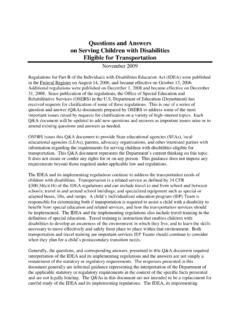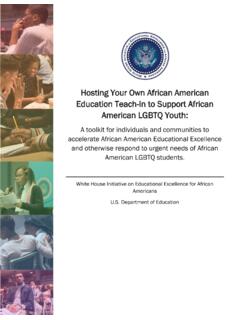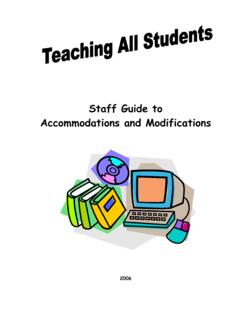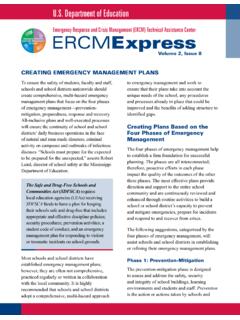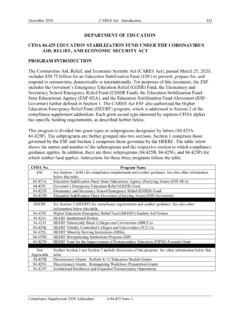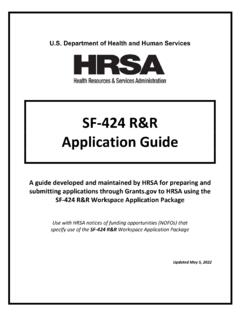Transcription of OSEP QA 21-06 RETURN TO SCHOOL ROADMAP
1 400 MARYLAND AVE. , WASHINGTON, DC 20202-2600 The department of education s mission is to promote student achievement and preparation for global competitiveness by fostering educational excellence and ensuring equal access. UNITED STATES department OF education OFFICE OF special education AND REHABILITATIVE SERVICES OSEP QA 21-06 RETURN TO SCHOOL ROADMAP :DEVELOPMENT AND IMPLEMENTATION OF INDIVIDUALIZED education PROGRAMS IN THE LEAST RESTRICTIVE ENVIRONMENT UNDER THE INDIVIDUALS WITH DISABILITIES education ACT September 30, 2021 The department of education ( department ), Office of special education and Rehabilitative Services (OSERS) has received requests from a diverse group of stakeholders asking that the department issue new guidance interpreting requirements of the Individuals with Disabilities education Act (IDEA) in light of the many challenges of the COVID-19 pandemic and as more schools and programs are returning to in-person services. Topics include meeting timelines, ensuring implementation of initial evaluation and reevaluation procedures, determining eligibility for special education and related services, and providing the full array of special education and related services that children with disabilities need in order to receive a free appropriate public education (FAPE).
2 1 In addition, stakeholders have inquired about the implications of delayed evaluations and early intervention services to infants and toddlers with disabilities and their families served under IDEA Part The purpose of the RETURN to SCHOOL ROADMAP IDEA guidance documents,3 which focus on SCHOOL reopening efforts, is to support the full implementation of IDEA requirements. The documents also serve to clarify that, regardless of the COVID-19 pandemic, or the mode of instruction, children with disabilities are entitled to FAPE, and infants and toddlers with disabilities and their families to appropriate IDEA Part C services. The department recognizes that some parents may have specific health and safety concerns about sending their children back to in-person instruction because of the health risk to the student, the student s immediate family, and to other household members even as parents are also concerned about their child missing the instructional and social and emotional opportunities 1 Free appropriate public education or FAPE means special education and related services that (1) are provided at public expense, under public supervision, and without charge; (2) meet the standards of the State educational agency (SEA), including the requirements of IDEA; (3) include an appropriate preschool, elementary SCHOOL , or secondary SCHOOL education in the State involved; and (4) are provided in conformity with an individualized education program that meets the requirements of 34 through 34 2 Additional guidance, including requirements of Part C of IDEA, will be forthcoming.
3 3 Other than statutory and regulatory requirements included in this Q&A document, the contents of this guidance do not have the force and effect of law and are not meant to bind the public. This document is intended only to provide clarity to the public regarding existing requirements under the law or agency policies. The questions and answers in this document are not intended to be a replacement for careful study of IDEA and its implementing regulations. The IDEA, its implementing regulations, and other important documents related to IDEA and the regulations are found at: RETURN TO SCHOOL ROADMAP : DEVELOPMENT AND IMPLEMENTATION OF IEPS 2 that come with in-person Therefore, reopening schools safely is of utmost importance. State educational agencies (SEAs) and local educational agencies (LEAs)5 should put in place layered prevention strategies, including promoting vaccination and universal and correct mask-wearing in schools. The Centers for Disease Control and Prevention (CDC) recommends that everyone in K through 12 schools wear a mask indoors, including teachers, staff, students, and visitors, regardless of vaccination CONTENTS Introduction.
4 3 A. Ensuring IEPs Are in Effect at the Start of the SCHOOL Year .. 5 B. Convening the IEP Team .. 10 C. Consideration of special Factors .. 13 Considering the Assistive Technology Needs of a Child with a Disability .. 13 Addressing the Social, Emotional, Behavioral, and Mental Health Needs of Children with Disabilities .. 15 Addressing the SCHOOL -Related Health Needs of Children with Disabilities with Underlying Medical Conditions .. 19 D. Determining Appropriate Measurable Annual Goals & Considering the Child s Need for Compensatory Services .. 24 E. Making Extended SCHOOL Year (ESY) Services Determinations .. 32 F. Considering Secondary Transition Services .. 34 G. Making Educational Placement Decisions .. 37 H. Resolving Disagreements Regarding a Child s Educational Program .. 40 4 ED COVID-19 Handbook Volume 1: Strategies for Safely Reopening Elementary and Secondary Schools. 5 To increase readability, the department has used the term LEA in place of public agency.
5 Public agency is defined in 34 to include the SEA, LEAs, educational services agencies (ESAs), nonprofit public charter schools that are not otherwise included as LEAs or ESAs and are not a SCHOOL of an LEA or ESA, and any other political subdivisions of the State that are responsible for providing education to children with disabilities. 6 Under Federal disability laws, exceptions can be made on an individual basis for a person who cannot wear a mask or cannot safely wear a mask because of a disability as defined by the Americans with Disabilities Act (42 12101 et seq.). See CDC s Guidance for COVID-19 Prevention in K-12 Schools, ; See also, the department s Vol. 1, ED COVID-19 Handbook, Strategies for Safely Reopening Elementary and Secondary Schools. RETURN TO SCHOOL ROADMAP : DEVELOPMENT AND IMPLEMENTATION OF IEPS 3 INTRODUCTION The department is committed to ensuring that children with disabilities receive the services and supports they are entitled to under IDEA so that they have successful educational experiences.
6 For more than a year, educators across the country have provided services and supports to children with disabilities in ways never anticipated prior to the COVID-19 pandemic. The department recognizes that SEAs and LEAs have worked hard to meet children s needs and provide required services, given the unprecedented educational disruptions and other challenges resulting from the Even with these efforts, some children with disabilities were unable to receive appropriate services to address their needs so that they could make progress toward achieving the functional and academic goals included in their individualized education programs (IEPs). Therefore, the department repeats and emphasizes that, notwithstanding the challenges associated with the COVID-19 pandemic, families and children retained their rights to receive appropriate services under IDEA. 34 In this document, the department highlights certain IDEA requirements related to the development and implementation of IEPs and other information that SEAs, LEAs, regular and special education teachers, related services providers, and parents should consider.
7 Parents who would like to request additional support in understanding IDEA s requirements may wish to contact their local regional parent training and information centers (PTIs) for direct assistance and referrals to other organizations and to gain skills to effectively participate in the education and development of their children. There are over 100 PTIs and Community Parent Resource Centers in the United States and Territories that provide training, resources, and support on a wide variety of topics. Parents can locate the appropriate PTI for their area at Although it is beyond the scope of this document, recipients of Federal financial assistance from the department ( , public agencies receiving IDEA funding) are reminded of their obligation 7 States have reported that these difficulties include challenges with providing the equipment and technology, including Wi-Fi access, needed for children to participate in virtual learning; having adequate personnel to provide early intervention, special education , and related services due to COVID-related illness and employees concerns for their safety and the safety of their families; and taking the necessary health and safety precautions required for public facilities to reopen.
8 8 This document contains examples of resources that are provided for the user s convenience. The inclusion of these resources is not intended to reflect their importance, nor is it intended to endorse any views expressed, or products or services offered, by these entities. These resources may include materials that contain the views and recommendations of various subject-matter experts as well as hypertext links, contact addresses, and websites to information created and maintained by other public and private organizations. The opinions expressed in any of these materials do not necessarily reflect the positions or policies of the department . The department does not control or guarantee the accuracy, relevance, timeliness, or completeness of any outside information included in the materials that may be provided by these resources. RETURN TO SCHOOL ROADMAP : DEVELOPMENT AND IMPLEMENTATION OF IEPS 4 to comply with Section 504,9 which prohibits discrimination on the basis of For example, in providing any aid, benefit, or service, a recipient may not, directly or through contractual, licensing, or other arrangements, deny a student with a disability an equal opportunity to participate in or benefit from the aid, benefit, or service.
9 34 (b)(1). This is especially relevant where States or SCHOOL districts, as a result of the pandemic, make available to all students additional educational programming or services, and choices for instructional delivery or program participation. 9 Children with disabilities also have rights under two civil rights laws that prohibit discrimination on the basis of disability Section 504 of the Rehabilitation Act of 1973, 29 794; 34 Part 104 (Section 504) and Title II of the Americans with Disabilities Act 42 12131-12134; 28 Part 35 (Title II). Section 504 prohibits disability discrimination by recipients of Federal financial assistance, such as SEAs and LEAs. Title II prohibits discrimination by public entities, including SEAs and LEAs, regardless of receipt of Federal financial assistance. The Office for Civil Rights (OCR) in the department of education enforces Section 504 in public elementary and secondary schools. Also, in this context, OCR shares in the enforcement of Title II with the department of Justice (DOJ).
10 DOJ is responsible for interpreting and providing technical assistance about the requirements of Title II. More information about these laws is available at: and 10 See, Questions and Answers on Civil Rights and SCHOOL Reopening in the COVID-19 Environment RETURN TO SCHOOL ROADMAP : DEVELOPMENT AND IMPLEMENTATION OF IEPS 5 A. ENSURING IEPS ARE IN EFFECT AT THE STA RT OF THE SCHOOL YEAR The cornerstone of IDEA is the entitlement of each eligible child with a disability to FAPE that emphasizes special education and related services designed to meet the child s unique needs and that prepares the child for further education , employment, and independent living. Under IDEA, the vehicle for providing FAPE is through an appropriately developed IEP based on the individual needs of the child. An IEP must include a child s present levels of academic achievement and functional performance, and the impact of a child s disability on their involvement and progress in the general education curriculum.


